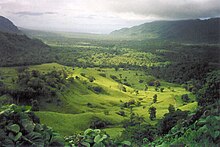Upolu
| Upolu | ||
|---|---|---|
| NASA image of Upolu | ||
| Waters | Pacific Ocean | |
| Archipelago | Samoa Islands | |
| Geographical location | 13 ° 55 ′ S , 171 ° 45 ′ W | |
|
|
||
| length | 75 km | |
| width | 24 km | |
| surface | 1 125 km² | |
| Highest elevation |
Mount Fito 1113 m |
|
| Residents | 143,418 (2011) 127 inhabitants / km² |
|
| main place | Apia | |
| Map of Upolu | ||
Along with Savaiʻi, Upolu is one of the two main islands of the Independent State of Samoa in the South Pacific. The largest city on the island is the capital Apia on the north coast of the island.
geography
The island used to be a large basalt volcano that is now completely overgrown. The entire island is surrounded by a coral reef. In the east of the island is the 56 meter high Fuipisia waterfall . The O Le Pupuʻe National Park on Upolu is one of the few national parks in the Pacific region. In it lie the peaks of the double-cratered mountain Le Pu'e and Mount Fito , at 1,113 meters the highest point of Upolus. The west of Upolus consists largely of white sand and black rocks: Here is also the Return to Paradise beach , which was named after the film of the same name with Gary Cooper . There are extensive, protected mangrove forests in the southwest of the island .
history
According to legend, Upolu got its name from the first woman who lived on this island. The island was discovered for Europe in 1722 by the Dutchman Jakob Roggeveen . He gave it the name "Groningen" after the Dutch city of Groningen . At the end of the 18th and beginning of the 19th century, the island was also called Ojalava or Ojolava .
At the end of the 19th century, Robert Louis Stevenson lived on the island. He managed the Vailima - plantation until his death in 1894. The Vailima plantation was the official residence of the German used the governor after 1899 Upolu part of Year colony German Samoa had become. During the First World War , the island was occupied by Great Britain and later transferred to New Zealand along with the other western Samoa Islands . On March 19, 1927, the second independence movement of the Mau a Pule was founded on the island against the foreign rule of New Zealand.
population
The population amounts to approx. 143,000 inhabitants (2011) of which approx. 37,000 live in the capital Apia.
The island is divided into five districts; Aʻana , Aiga-i-le-Tai , Atua , Tuamasaga and Vaʻao-Fonoti .
The main airport is Faleolo International Airport in the northwest. Fagali'i (IATA code: FGI ), 5 km east of Apia, is only approved for regional flights.
Inside the island there is a Baha'i Temple , with a monumental dome and imposing buildings around it .
Individual evidence
- ^ Carl Friedrich Behrens: The well-attempted southerner, trip around the world 1721/22, reprinted by Brockhaus-Verlag Leipzig 1923, p. 93
Web links
- Picture and short description ( memento from December 23, 2010 in the Internet Archive )
- Upolu in the Global Volcanism Program of the Smithsonian Institution (English)
- Almost like a woman: The Faafafines from Upolu





